- Struggling with sunscreen and seborrheic dermatitis? You’re not alone.
- Irritation is a common problem. Learn how to choose sunscreens that soothe, not sting.
- Mineral sunscreens are often the best choice. Discover why zinc oxide and titanium dioxide are your allies.
- Ingredient know-how is key. Find out what to look for (and what to avoid) on the label.
- Product recommendations included. Explore mineral sunscreens that might just be your skin’s new best friend.
It’s challenging enough navigating the world of sunscreens, but when you have seborrheic dermatitis-prone skin, the task becomes exponentially harder. The very product meant to protect can often trigger irritation and worsen your condition. Applying a thick, potentially pore-clogging layer of sunscreen onto already inflamed skin feels counterintuitive, and with a compromised skin barrier, concerns about ingredient penetration and potential reactions are amplified.
This article consolidates extensive research to guide you in selecting sunscreens that are most compatible with seborrheic dermatitis. Rather than focusing on specific brands, we’ll delve into the fundamentals of sunscreen, its benefits, the technology behind it, and the crucial characteristics that make a sunscreen suitable for those of us with seborrheic dermatitis-prone skin.
We hope this guide proves helpful! Please share any questions or sunscreen suggestions in the [comments][1] section below.

Why Sunscreen Matters
Solar ultraviolet radiation is a well-established cause of melanoma, a serious form of skin cancer that is increasingly prevalent, especially among fair-skinned populations.
Melanoma development is linked to malignant keratinocytes (skin cells) resulting from UVR-induced DNA damage [1].
Sunscreen offers a way to reduce melanoma risk by minimizing this UVR-induced DNA damage.
While older studies had inconclusive results [2], more recent research supports the use of sunscreens with SPF 15 or higher [3]. However, some experts point out that sunscreen might create a false sense of security, encouraging people to spend excessive time in the sun, potentially reducing its overall effectiveness [4].
Despite these discussions, major health organizations recommend sunscreen use. The Sunscreen Summit Policy Group in Australia and New Zealand, for instance, advises sunscreen application whenever the outdoor UV index reaches 3 or above – which is common for a significant portion of the year in many regions [5]. This recommendation even applies when no extended outdoor activities are planned.
Furthermore, a comprehensive 2017 meta-analysis, reviewing numerous studies, reinforces the benefit of sunscreen in reducing UVR-induced DNA damage [6].

Understanding Sunscreen Technology
The sun emits three types of ultraviolet radiation: UVA, UVB, and UVC. UVA freely penetrates the ozone layer, UVB is partially absorbed, and UVC is entirely absorbed by the ozone layer.
Prolonged UVA and UVB exposure is linked to various detrimental skin effects, including increased melanoma risk, oxidative stress, DNA and protein damage, lipid damage, and immune system compromise [7, 8, 9].
Sunscreen’s primary function is to shield the skin from this harmful ultraviolet radiation.
This protection is achieved through two main types of filters:
- Chemical (organic) filters: Absorb UV rays.
- Examples: Octyl methoxycinnamate, Octocrylene, Benzophenone-3, 3-benzylidene camphor, Octocrylene
- Physical (inorganic) filters: Deflect UV rays.
- Examples: Zinc oxide, Titanium dioxide, Iron oxide
Modern sunscreens often combine multiple filters to provide broad-spectrum UV protection, leveraging the unique properties of each filter type.

Beyond UV filters, topical antioxidants have shown promise in mitigating UV damage. Some sunscreen formulations include antioxidants such as:

Key Criteria for Seborrheic Dermatitis Sunscreen
When you have seborrheic dermatitis, choosing a sunscreen requires extra consideration. Here’s what to keep in mind:
- Skin Barrier Sensitivity: The more severe your seborrheic dermatitis symptoms, the more compromised your skin barrier. This increased permeability means your skin is more susceptible to absorbing topical agents and reacting to irritants.
- Prioritize simple, minimal formulas: Opt for sunscreens with fewer ingredients and UV filters known for low toxicity and minimal skin penetration.
- Choose physical over chemical filters: Chemical filters are absorbed into the skin more readily than physical filters like zinc oxide. They can even enter the bloodstream and potentially breast milk [19]. Some researchers have raised concerns about their potential toxicity [20].
- Malassezia and Ingredients: Since Malassezia yeast plays a role in seborrheic dermatitis, sunscreen ingredients shouldn’t promote its growth.
- Consider anti-fungal properties: Some sunscreen agents may have anti-fungal benefits against Malassezia.
- Zinc oxide as an anti-fungal agent: Zinc oxide shows promise as an anti-fungal [21], with its effectiveness increasing as particle size decreases (nanoparticles) [22].
- The skin microbiome and UV protection: Interestingly, Malassezia furfur produces pityriacitrin, a compound offering UV protection [23, 24]. Anti-fungal treatments to reduce Malassezia might inadvertently affect this natural protection.
- Oxidative Stress and Antioxidants: Seborrheic dermatitis is associated with increased oxidative damage and reduced redox capacity (the skin’s ability to neutralize free radicals) [25, 26].
- Antioxidant-rich sunscreens may be beneficial: Sunscreens with ample antioxidants can provide added protection against UV damage and potentially support skin health in seborrheic dermatitis.
Quick Checklist for Optimal Sunscreen
The ideal sunscreen for seborrheic dermatitis-prone skin should:
- Provide broad-spectrum UV protection
- Be low-irritation:
- Fragrance-free
- Contain gentle preservatives with a good safety record
- Avoid avobenzone [27]
- Have low toxicity concerns
- Offer potential anti-fungal benefits
- Include antioxidant support
Based on these criteria, mineral sunscreens using a combination of zinc oxide and titanium dioxide emerge as strong contenders:
- Broad UV protection: Zinc oxide and titanium dioxide together offer comprehensive UV coverage [28].
- Safety and low toxicity: They are known for their safety and minimal toxicity concerns [29].
- Anti-bacterial properties: Zinc oxide nanoparticles exhibit antibacterial effects [30].
A simple, fragrance-free formula with zinc oxide and titanium dioxide, incorporating a few beneficial antioxidants, appears to be the most suitable choice.
Additional desirable factors:
- Affordability
- Accessibility
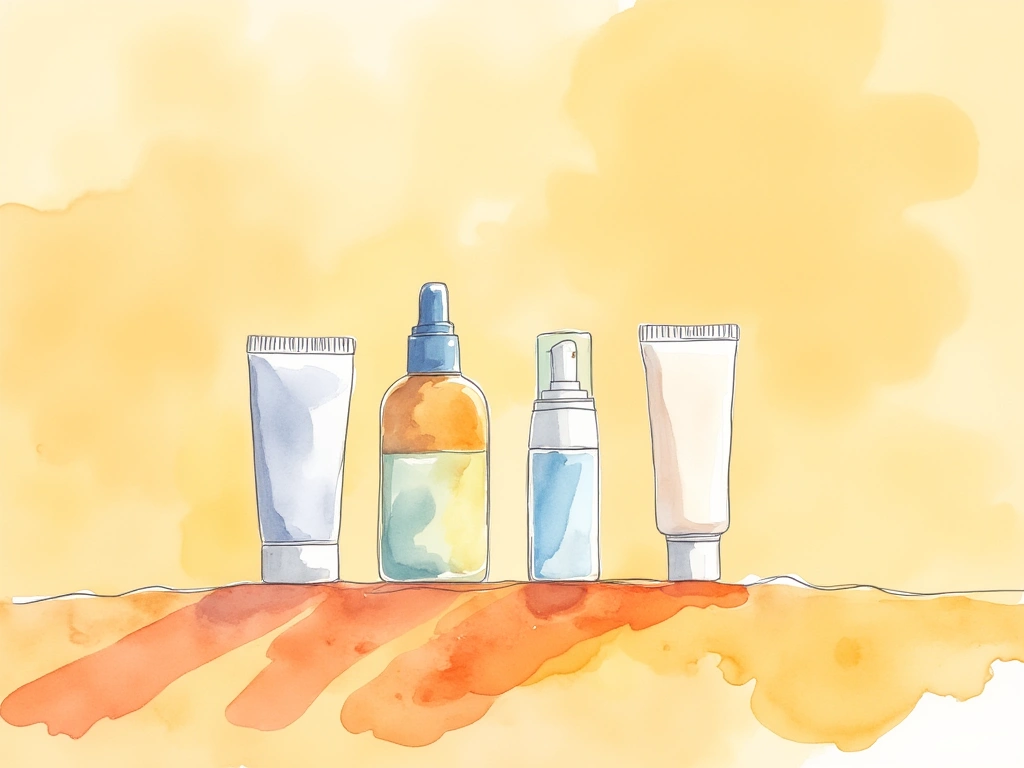
Sunscreen Candidates for Seborrheic Dermatitis
Considering the above criteria, here are mineral-based sunscreens that may be worth trying. The list is ordered roughly by preference based on the discussed factors.
Thinkbaby Safe Sunscreen – SPF 50+
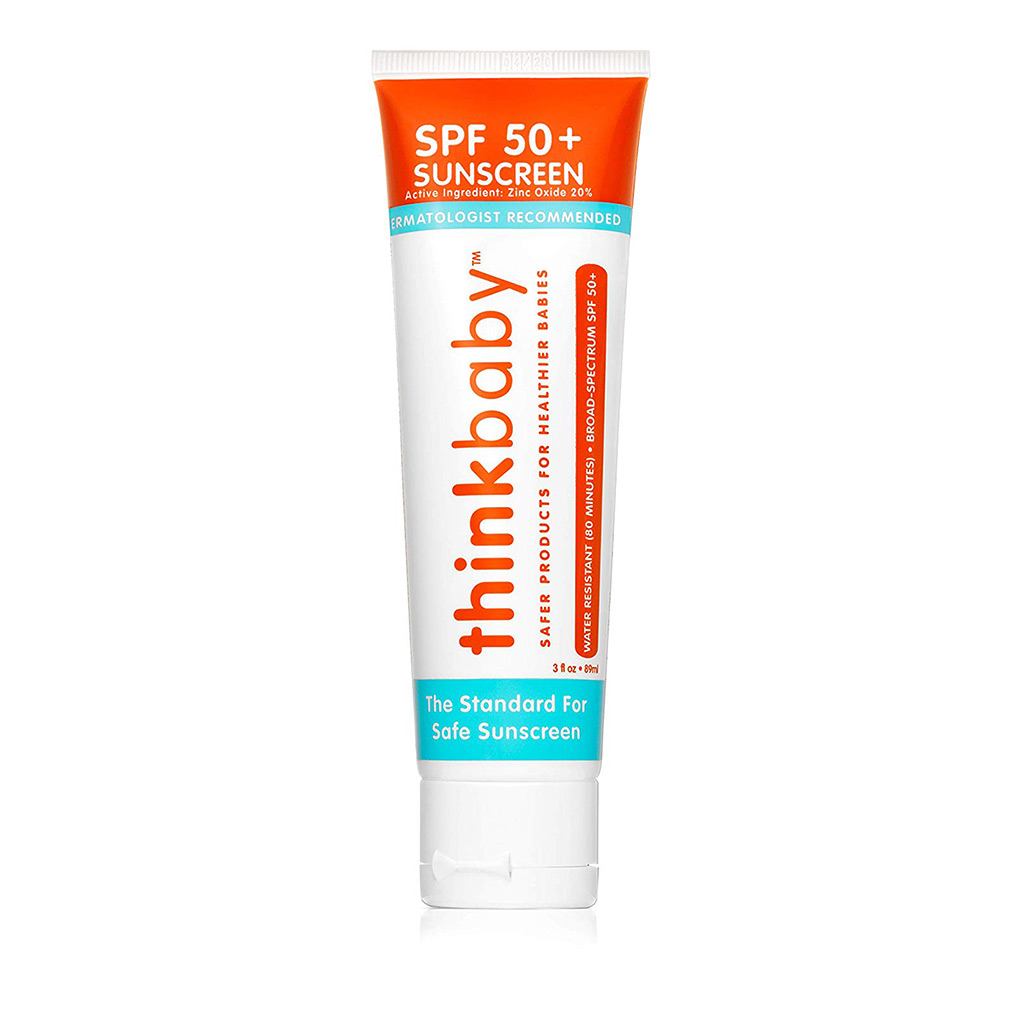
This sunscreen features a straightforward formula with natural oils, likely providing good moisturization. While some might worry about oils potentially feeding Malassezia, the high zinc oxide concentration and overall formulation context might mitigate this concern.
It also includes Vitamin E (tocopherols) and Vitamin C, offering antioxidant benefits.
Zinc Oxide 20% (Non-Nano) Purified Water, Aloe Barbadensis Leaf Juice, Capric/Caprylic Triglycerides, Sorbitan Stearate, Methyl Abietate, Vegetable Glycerin, Cetyl Dimethicone, Hydrogenated Castor Oil, Magnesium Sulfate, Sunflower Oil, Jojoba Oil, Ascorbic Acid, Tocopherols , Olive Oil, Raspberry Seed Oil, Cranberry Seed Oil, Hyaluronic Acid, Glucose Oxidase, Lactoperoxidase, Papaya
Baby Bum – Fragrance Free – SPF 50
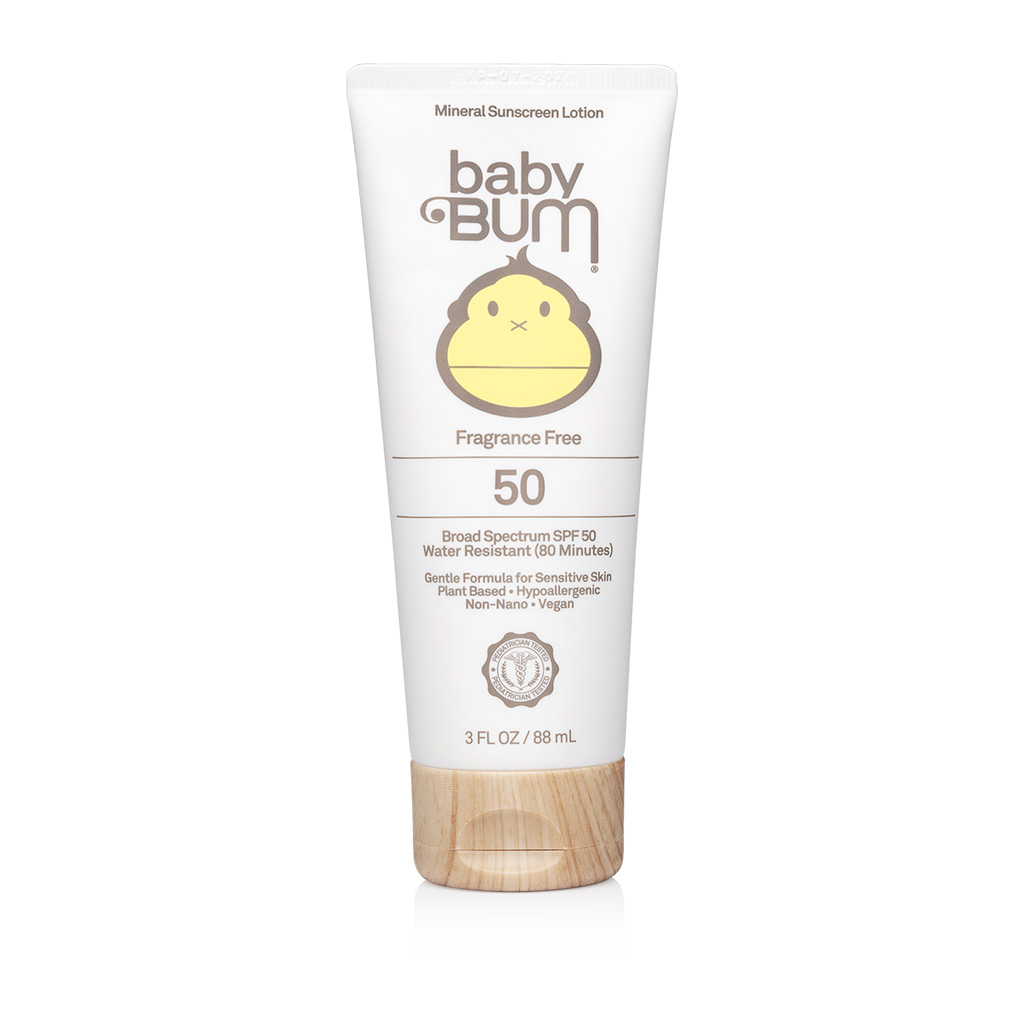
Baby Bum offers another simple, naturally-oriented formula, likely lighter and more fluid in texture than ThinkBaby.
Zinc Oxide (20%) Water, Cocos Nucifera (Coconut) Oil, Butyloctyl Salicylate, Diheptyl Succinate, Methyl Dihydroabietate, Butyrospermum Parkii (Shea Butter), Capryloyl Glycerin/Sebacic Acid Copolymer, Sodium Stearoyl Glutamate, Cetearyl Alcohol, Theobroma Cacao (Cocoa) Seed Butter, Sodium Hyaluronate, Bisabolol, Tocopherol, Coco-Glucoside, Microcrystalline Cellulose, Cellulose Gum, Cetyl Alcohol, Arachidyl Alcohol, Behenyl Alcohol, Arachidyl Glucoside, Polyhydroxystearic Acid, Sodium Gluconate, Phenoxyethanol, Ethylhexylglycerin, Citric Acid
Burt’s Bees Baby – Nourishing Mineral Sunscreen – SPF 30
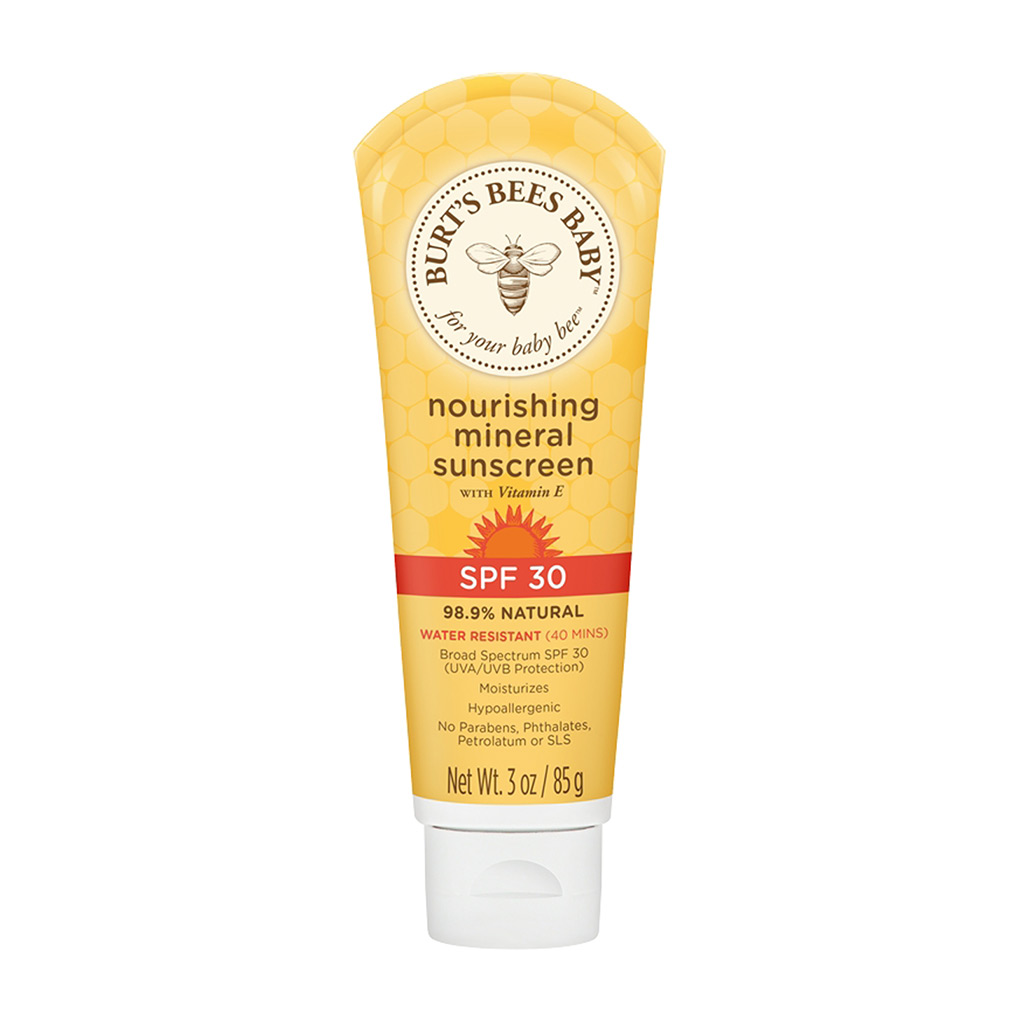
This option has a slightly longer ingredient list but combines both titanium dioxide and zinc oxide for enhanced UV protection.
It also includes coffee extract, possibly for its skin-benefiting properties, though its concentration and purpose are unclear.
Titanium dioxide 2.8%; Zinc oxide 13%. Water, dicaprylyl ether, carthamus tinctorius (safflower) oleosomes, caprylic/capric triglyceride, glycerin, beeswax, cetyl alcohol, nelumbo nucifera flower wax, phenoxyethanol, isostearic acid, polyhydroxystearic acid, alumina, lecithin, polyglyceryl-3 polyricinoleate, gluconic acid, lonicera japonica (honeysuckle) flower extract, sodium benzoate, stearic acid, lonicera caprifolium (honeysuckle) flower extract, sodium phytate, prunus armeniaca (apricot) fruit extract, pyrus malus (apple) fruit extract, tocopherol, cocos nucifera (coconut) fruit extract, coffea arabica (coffee) seed extract, dipteryx odorata seed extract, vanilla planifolia fruit extract, alcohol, potassium sorbate.
Blue Lizard – Australian Sunscreen – Sensitive Mineral Sunscreen- SPF 30+
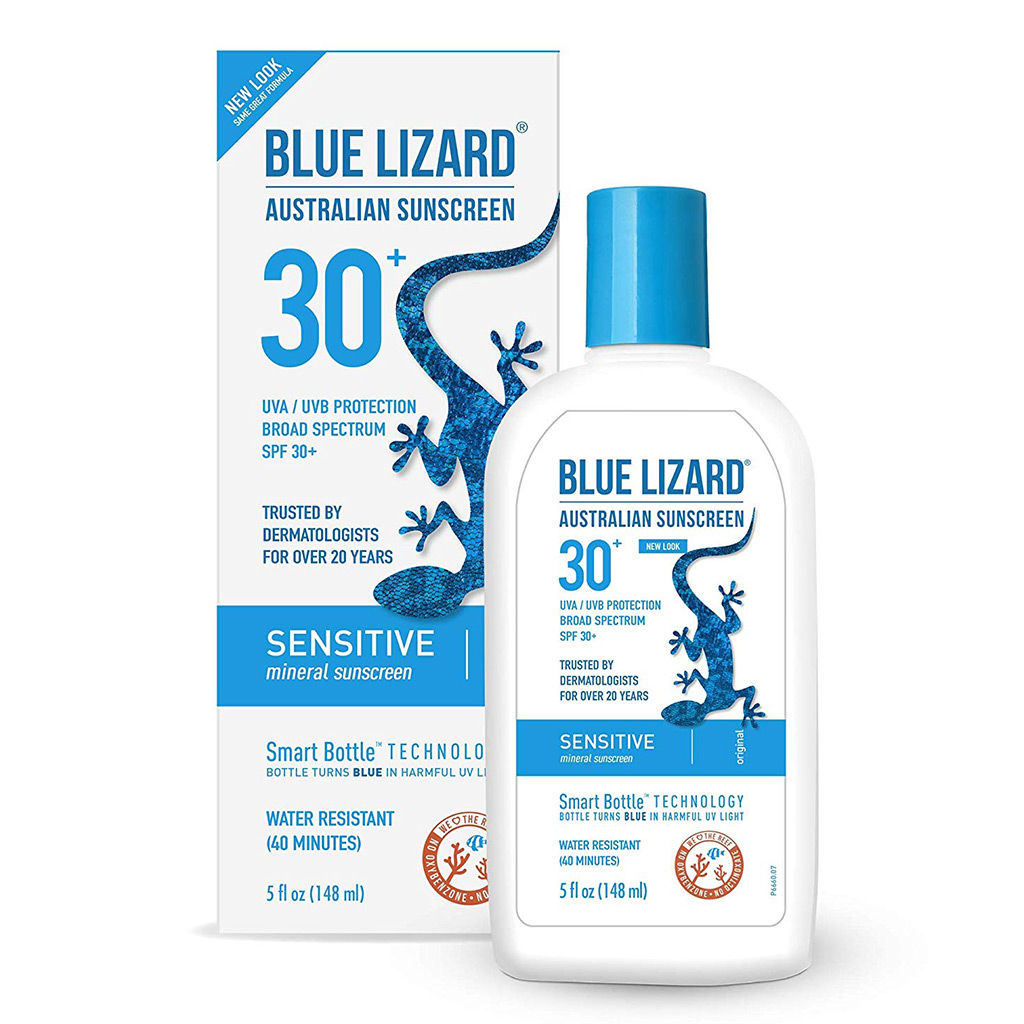
While not the most natural formula, Blue Lizard is readily available and reasonably priced, making it accessible. Patch test first to check for sensitivity.
Zinc Oxide 10%, Titanium Oxide 5% Beeswax, C12-15 Alkyl Benzoate, Caprylyl Glycol, Cetyl Dimethicone and/or Cetyl Dimethicone Copolyol, Chlorphenesin, Disodium EDTA, Ethyhexyl Palmitate, Ethyhexyl Stearate, Hexyl Laurate, Hydrogenerated Castor Oil, Methyl Glucose Dioleate, Octododecyl Neopentanoate, PEG-7 Hydrogenated Castor Oil, phenoxyethanol, Polyglyceryl-4 Isostearate, Propanediol, Purified Water, Sorbitan Oleate, Stearic Acid, Tocopheryl Acteate, Trimethylated Silica/Dimethicone, VP Hexadecene Copolymer
Aveeno Kids – Continuous Protection – Zinc Oxide Sunscreen – SPF 50
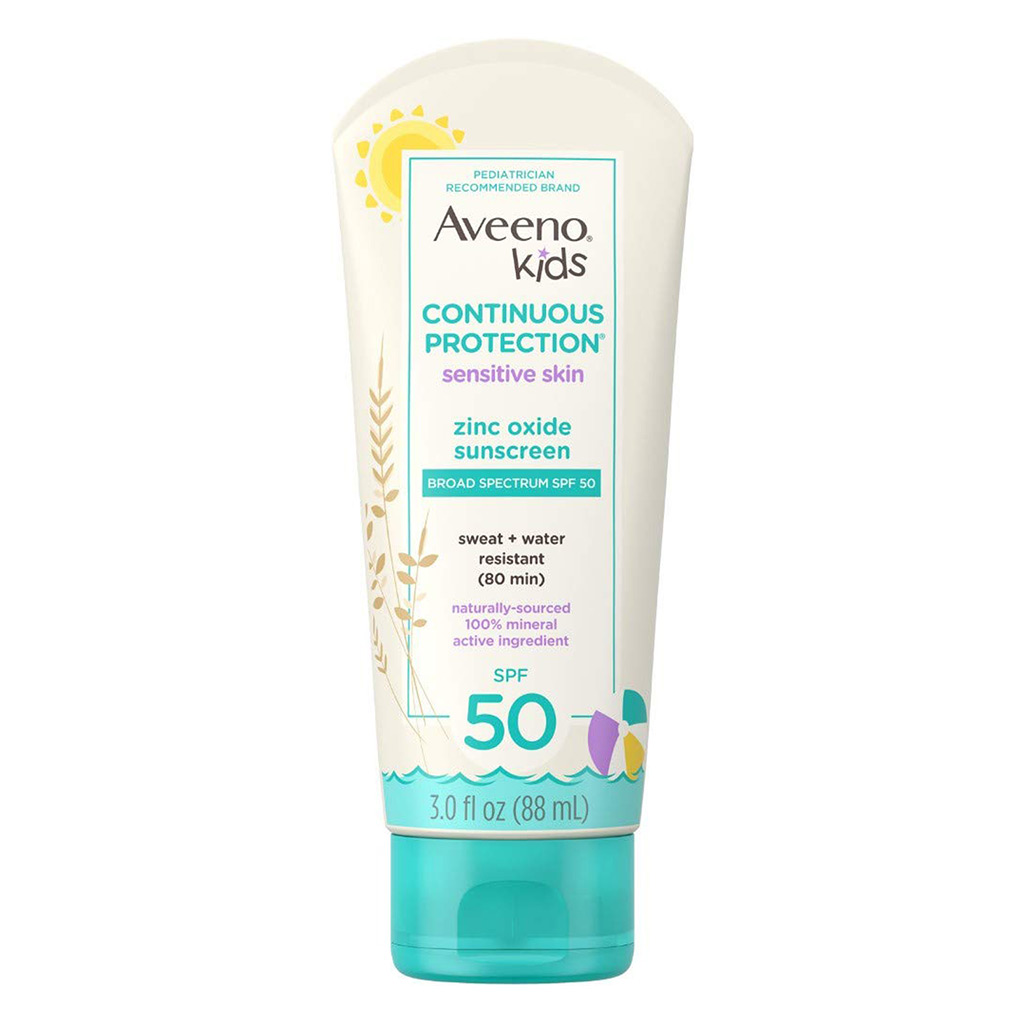
Aveeno Kids is another zinc oxide-based sunscreen. Despite its “natural” packaging, the formula is more silicone and polymer-based. However, Aveeno’s widespread availability is a significant advantage.
Zinc Oxide (21.6%) Water, C12-15 Alkyl Benzoate, Styrene/Acrylates Copolymer, Octyldodecyl Citrate Crosspolymer, Phenyl Trimethicone, Cetyl PEG/PPG-10/1 Dimethicone, Dimethicone, Polyhydroxystearic Acid, Glycerin, Ethyl Methicone, Silica, Cetyl Dimethicone, Triethoxycaprylylsilane, Phenoxyethanol, Glyceryl Behenate, Sodium Chloride, Acrylates/Dimethicone Copolymer, Chlorphenesin, Phenethyl Alcohol, Avena Sativa (Oat) Kernel Flour, Caprylyl Glycol, Cetyl Dimethicone/Bis-Vinyldimethicone Crosspolymer, Chrysanthemum Parthenium (Feverfew) Flower/Leaf/Stem Juice
EltaMD – UV Physical – Broad Spectrum – SPF 41
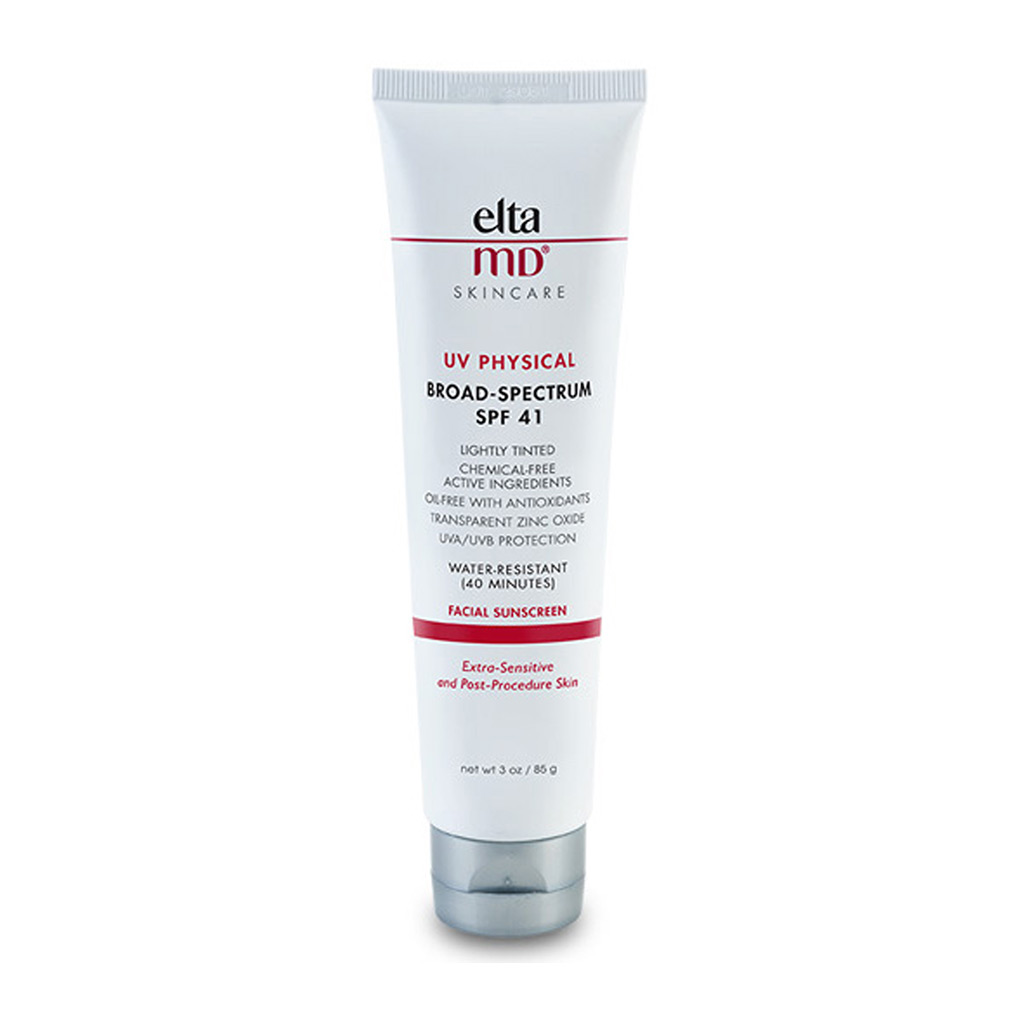
EltaMD UV Physical is a premium-priced option featuring “transparent zinc oxide” (likely nano-sized particles).
It combines titanium dioxide and zinc oxide for broad protection and includes aluminum oxide (alumina) and iron oxide. Quercetin is present, but low on the ingredient list, suggesting a minimal concentration, and common antioxidants are absent.
9.0% transparent zinc oxide, 7.0% titanium dioxide Alumina, Butylene Glycol, Citric Acid, Iodopropynyl Butylcarbamate, Iron Oxide, Isopropyl Palmitate, Lecithin, Linoleic Acid, Hydrogen Dimethicone, Octyldodecyl Neopentanoate, Octyl Stearate, Oleth-3 Phosphate, Perfluorononyl Dimethicone, Phenoxyethanol, Polyacrylate 13, Polyisobutene, Polysorbate 20, Purified Water, Quercetin, Sodium Hydroxide, Thioctic Acid (Alpha Lipoic Acid), Triethoxycaprylylsilane.
Australian Gold – Botanical Sunscreen – SPF 50
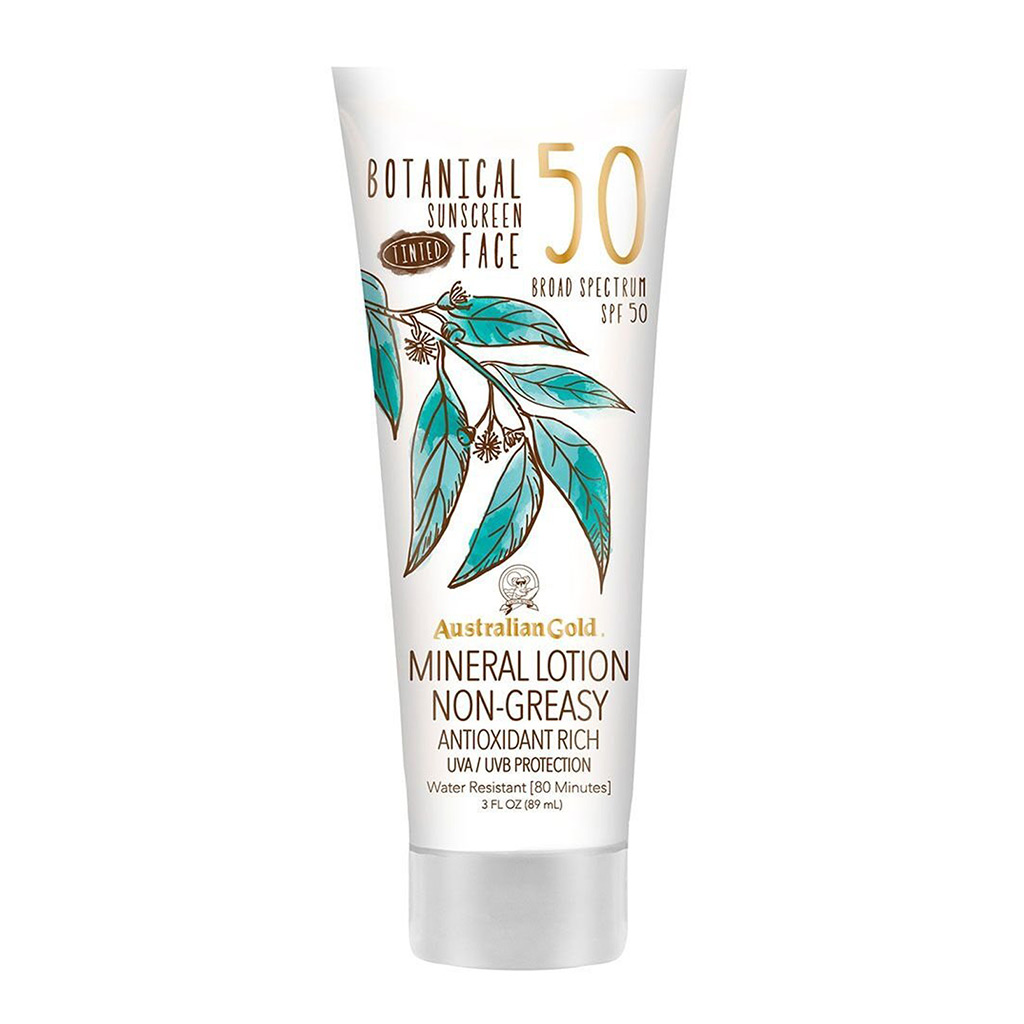
Australian Gold Botanical Sunscreen has low concentrations of active ingredients but achieves a high SPF rating, likely due to aluminum oxide and iron oxide [31].
Despite “botanical” labeling, it contains silicones and polymers.
Titanium Dioxide 4%, Zinc Oxide 4% Alumina, Butyrospermum Parkii (Shea) Butter, Caprylyl Glycol, Cetyl PEG/PPG-10/1 Dimethicone, Cyclopentasiloxane, Dimethicone Crosspolymer, Disodium EDTA, Disteardimonium Hectorite, Eucalyptus Globulus Leaf Extract, Glycerin, Hexyl Laurate, Iron Oxides, Panthenol, PEG-10 Dimethicone, Phenoxyethanol, Polyglyceryl-4 Isostearate, Polymethylsilsesquioxane, Porphyra Umbilicalis (Red Algae) Extract, Silica, Squalane, Stearic Acid, Terminalia Ferdinandiana (Kakadu Plum) Fruit Extract, Tocopheryl Acetate*, Triethoxycaprylylsilane, Water *Vitamin E

More Sunscreen Tips for Seborrheic Dermatitis
Here are some extra considerations for effective and comfortable sun protection when you have seborrheic dermatitis:
Apply Enough Sunscreen
Sunscreen effectiveness directly depends on adequate skin coverage [32]. Think of sunscreen as a protective layer – gaps reduce its effectiveness. Even imperfect application is better than none [33], but most people typically apply less sunscreen than needed to achieve the labeled SPF.
Consider Your Pre-Sun Exposure Skincare
Sebum (skin oil) itself offers some UV protection [34, 35]. Over-cleansing might contribute to increased melanoma rates by stripping away this natural protection. Evaluate your skincare routine before sun exposure; perhaps a gentler approach is beneficial.
Gentle Sunscreen Removal
Given the compromised skin barrier in seborrheic dermatitis, removing sunscreen should be gentle, especially water-resistant formulas. Research from Sichuan University suggests cleansing oils are most effective at sunscreen removal while minimizing irritation and dryness [36].
Diet and Sun Protection
What you eat can also bolster your sun protection.
- Antioxidants: Beta-carotene, vitamin C, and vitamin E have strong evidence for photoprotective benefits [37, 38].
- Polypodium leucotomos extract: Extract from this fern may offer photoprotection [39].
- Omega-3s and green tea polyphenols: These may enhance skin’s immune response to UV damage [40, 41].
Embrace Traditional Sun Protection
Don’t overlook classic sun protection methods like hats, clothing, and umbrellas. They offer excellent protection with minimal risk of irritation.
Vitamin D and Sunscreen
While sunscreen use and Vitamin D deficiency is a common concern, moderate daily sunscreen use is unlikely to significantly impair Vitamin D synthesis in most people. However, individuals with pre-existing low Vitamin D levels, common in seborrheic dermatitis [42], should consult their doctor about supplementation.
Ingredient Awareness
Be wary of sunscreens marketed as “mineral-based” that also contain chemical UV filters. Always check the ingredient list to confirm the active ingredients and make informed choices.
Mineral SPF Moisturizers: A Challenge
Many moisturizers with SPF rely on chemical UV filters due to the potential for white cast from mineral filters like zinc oxide and titanium dioxide. Finding mineral-based SPF moisturizers that are aesthetically pleasing can be difficult.

In Conclusion
Hopefully, you now have a clearer understanding of sunscreen options and how to choose the best one for seborrheic dermatitis-prone skin. Here’s a quick summary:
- Extensive research links excessive UV radiation exposure to increased melanoma risk.
- Sunscreen’s primary purpose is to minimize UV radiation reaching the skin, potentially lowering skin cancer risk.
- UV protection is achieved via chemical filters (absorbing UV) and physical filters (reflecting UV).
- Physical filters zinc oxide and titanium dioxide are generally safe, provide excellent UV protection, and are well-suited for seborrheic dermatitis. Zinc oxide may even offer anti-fungal benefits against Malassezia.
- Minimize irritation by choosing simple, fragrance-free formulas with gentle preservatives. Be cautious of excessive nanotechnology.
- Antioxidants in sunscreen can enhance UV protection and may benefit seborrheic dermatitis by combating oxidative damage.
- ThinkBaby Safe Sunscreen, Baby Bum Fragrance Free, and Burt’s Bees Baby Nourishing Mineral Sunscreen are highlighted as good mineral-based options.
- Beyond sunscreen formulas, remember broad-brimmed hats, sun-protective clothing, seeking shade, dietary antioxidants, and gentle skincare practices for comprehensive sun safety.
We hope this information is helpful. Please share your sunscreen recommendations or any questions you have in the comments!
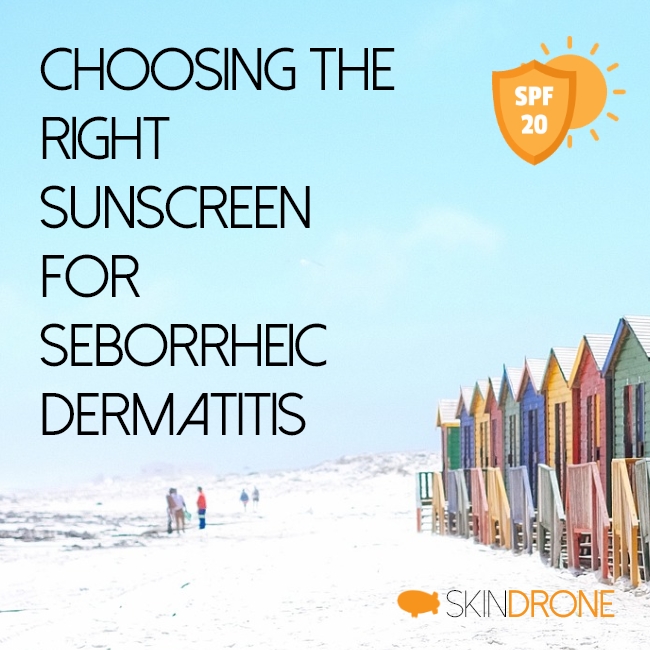
This weekend i will go to seaside, i was wondering how can i protect my skin.
Reply PermalinkI’m not a sun bathing guy, probable i’ll have a beer in the shade untill i get a good sunscreen :).
thank you Michael for sharing.
Yeah, shade’s probably the best natural sunscreen out there.
Reply PermalinkThanks for checking-in.